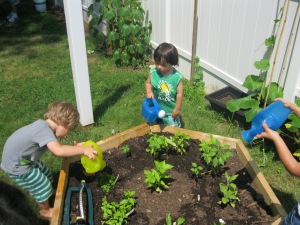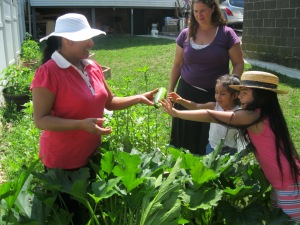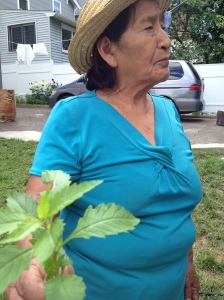Felicitas, a family child care provider who has been working with All Our Kin for years, is a native of the state of Puebla, Mexico and has lived in the United States for 20 years. She is also participating in the Garden Project, which has supplied 15 providers with raised garden beds, gardening supplies, and additional support in creating educational gardens from both All Our Kin and Common Ground. Señora Teresa, Felicitas’ mother, is visiting from Mexico and has also been working in the gardens in her daughter’s yard.
The two are growing Mexican plants from seed and nurturing others that have appeared. While many here think of these as weeds or “bad plants,” they are actually edible and even sold in farmers’ markets in Mexico. “My mom has sent me many seeds, but they don’t all grow, because of the climate,” said Felicitas. The plants that have grown well are alache, the principal ingredient in sopa de violeta; verdolaga, used in sofritos and moles; quelite or aplagada, a leaf that is steamed with garlic, salt and onion (lemon juice and spicy chilies are optional); and epazote, an herb similar to mint but without the same sweetness, that is used to season chileatole. In fact, during our visit Felicitas prepared quesadillas with epazote, a delicious snack with a very special flavor.
***
Sopa de violeta
4 portions
Put one liter of water up to boil. Add two cloves of chopped garlic, salt to taste, and half a chopped onion. When the water is boiling, add one pound of chopped alache leaves and pipicha. The soup can be served hot or cold, with lemon and spicy chilies.
Told by Señora Teresa and Felicitas.
***
Señora Teresa used to be a farmer in the countryside of Puebla, and grew “onion, radish, corn, beans, squash, and flowers.” While sharing her recipes, she commented, “These are foods that you don’t find here. They are from the [Mexican] countryside. In the countryside, the food is humble. Instead of eating meat, you can cook squash, green beans, zucchini, and squash blossoms.” Everyone is familiar with and knows how to prepare almost everything that comes out of the earth.
Looking at her zucchini patch, Felicitas comments, “There is very little space. If I had six plants instead of three, I could make zucchini flower soup.” She explains that there are two types of flowers – those that grow into zucchinis and those that don’t. The ones that aren’t attached to baby zucchinis are the ones to cut. She goes out every morning to cut one or two flowers, and every third morning, there are zucchini flower quesadillas for breakfast. “It’s very easy,” Felicitas says.
***
Zucchini Flower Quesadillas
4-6 portions
Finely chop 6-8 fresh zucchini flowers and 1-2 zucchinis (harvested from your garden, ideally). Take 4-6 whole-wheat flour tortillas, and grate a generous handful of mozzarella or fresh Latino-style white cheese for each. In the middle of each tortilla, put a handful of cheese and some of the flower and zucchini mixture. Place a tortilla on a pan on the stove and toast each side for about two minutes. Add salt and chilies to taste.
***
In 2000, when Felicitas was pregnant with her son, she had cravings for sopa de violeta. “Thinking about it made my mouth water,” she recalled. But she lived in an apartment, and had to go visit her brother in Hartford to eat alache. “It was a special day,” she remembers. “These are the flavors that I missed.”
 Felicitas is happy that she lives in a place where she can plant and grow a garden. She now has garden beds made by her husband and three new ones from the Garden Project. And she has a lot of help with her garden. “My favorite thing to do in the garden is help the plants,” one child in her day care declared. The children in Felicitas’ care participate in all aspects of the garden, helping with planting, growing, and harvesting. As one child exclaimed after a watering activity, “That plant was so thirsty it drank my whole bucket!”
Felicitas is happy that she lives in a place where she can plant and grow a garden. She now has garden beds made by her husband and three new ones from the Garden Project. And she has a lot of help with her garden. “My favorite thing to do in the garden is help the plants,” one child in her day care declared. The children in Felicitas’ care participate in all aspects of the garden, helping with planting, growing, and harvesting. As one child exclaimed after a watering activity, “That plant was so thirsty it drank my whole bucket!”
The children enjoy the vegetables in the kitchen as well, and they have already tried zucchini flower quesadillas and nopal, a typical cactus plant from Puebla. As Felicitas remembers, “I grew up with this, planting, caring for, harvesting, and then eating the garden plants. It was part of my family’s income.” To have a garden with all the plants of her childhood “is a way of connecting to my roots,” Felicitas says.
***
Sopa Azteca
4-6 portions
Put a liter of water up to boil. Add a little olive oil, onion, and two cloves of chopped garlic. Once the water boils, add two pounds of finely chopped zucchini flowers and salt to taste. Then add fresh Latino style white cheese. Once the flowers are cooked, turn off the heat and the soup is ready. It is served with pieces of tortilla, and pieces of beef if you have any.
Told by Señora Felicitas.
***





Great work by the child for a watering activity in a garden to grow up.
Good posting about the Mexican garden.thanks for the information about Mexican garden.